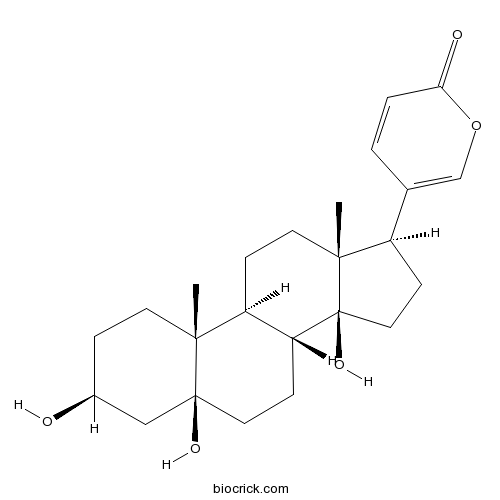InChI=1S/C24H34O5/c1-21-9-5-16(25)13-23(21,27)11-7-19-18(21)6-10-22(2)17(8-12-24(19,22)28)15-3-4-20(26)29-14-15/h3-4,14,16-19,25,27-28H,5-13H2,1-2H3/t16-,17+,18-,19+,21+,22+,23-,24-/m0/s1
Telocinobufagin (TCB), a bufadienolide extracted from Bufo paracnemis parotoid glands, shows a reversible local anesthetic action, similar to BUPI, however, without cardiac toxicity in vitro. [1]
Telocinobufagin is a novel endogenous digitalis, exhibits elevated plasma levels in patients with terminal renal failure.[2]
Telocinobufagin and marinobufagin have antimicrobial activity, the minimum inhibitory concentrations of telocinobufagin and marinobufagin were, respectively, 64.0 and 16.0 microg/mL for E. coli and both 128 microg/mL for S. aureus; they also promote an increase of the contraction force in isolated frog ventricle strips.[3]
Telocinobufagin has potential immune system regulatory effects, suggests that it could be developed as a novel immunotherapeutic agent to treat and other immune-mediated diseases, and it may become a new immunomodulatory agent in many regions.[4]
Telocinobufagin can enhance the Th1 immune response and protect against Salmonella typhimurium infection .[5]
Telocinobufagin can induce colon cancer cell apoptosis by oxidative stress and apoptosis pathway.[6]
English website: Telocinobufagin
Japanese website: Telocinobufagin
Chinese website: Telocinobufagin
[1] Patrocínio B A, Claúdio M. Universidade Federal do Ceará, 2004.5.26.
[2] Komiyama Y, Dong X N, Masaki H, et al. Clin Biochem, 2005, 38(1):36-45.
[3] Cunha Filho G A, Schwartz C A, Resck I S, et al. Toxicon, 2005, 45(6):777-82.
[4] Cao Y, Song Y, An N, et al. Fund Clin Pharmacol, 2009, 23(4):457-64.
[5] Wu S C, Fu B D, Shen H Q, et al. Int Immunopharmacol, 2015, 25(2):353-62.
[6] Liang S T, Li X W, et al. Nan Fang Yi Ke Da Xue Xue Bao 2016, 36(7):921-6.
[7] Ma X C, Zhang B J, Xin X L, et al. Nat Prod Co, 2009, 4(4):179-84.



